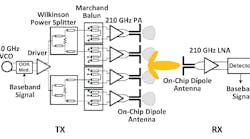Single-Layer PCB Supports Millimeter-Wave Applications
The benefits of high bandwidth, narrow beam widths, and unlicensed spectrum are increasing exploration into millimeter-wave designs in the 60-GHz range. Small wavelengths at these frequencies enable large-element phased arrays in small physical areas. Yet those small wavelengths require higher tolerances and greater detail considerations during design, which often increases the cost of fabrication. To decrease a common cost factor of printed-circuit-board (PCB) design, researchers Mingjian Li, and Kwai-Man Luk from the City University of Hong Kong developed a single-layer PCB phased-array antenna. It uses reflector-backed, one-wavelength bowtie antennas combined with double-loop antennas.
The antenna array is built upon a single-layer RT Duroid RF laminate, which is required for high-frequency transmission through the board. A 4-, 14-, and 50-element array were each fabricated and tested for maximum gain, aperture efficiency, and radiation efficiency. Compared to several antennas and arrays from literature, the proposed system performs comparably while providing stable input impedance.
The antenna arrays exhibited low cross-polarization and back-radiation levels. Enabling a low-cost platform for millimeter-wave systems may help to advance the adoption of such technologies in everyday devices. See “A Low-Profile Unidirectional Printed Antenna For Millimeter-Wave Applications,” IEEE Transaction On Antennas and Propagation, March 2014, p. 1232.
This file type includes high resolution graphics and schematics when applicable.


